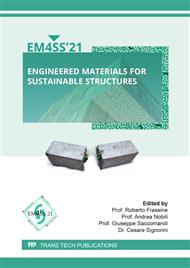[1]
CEB Comité Eurointernational du Beton. Durable Concrete Structures, bulletin n. 148 (1st ed.) 1982; bulletin n. 182 (2nd ed.) (1989).
Google Scholar
[2]
L. Bertolini, B. Elsener, P. Pedeferri, E. Redaelli, R. Polder. Corrosion of steel in concrete – prevention, diagnosis, repair, 2nd ed. Weinheim: Wiley VCH, (2013).
DOI: 10.1002/9783527651696
Google Scholar
[3]
P. Pedeferri. Corrosion science and engineering, ed. L. Lazzari and M. Pedeferri. Cham, Switzerland: Springer Nature, (2018).
Google Scholar
[4]
S. Matthews, FIB Model Code 2020, life-cycle management of existing concrete structures and the potential benefits of building as little as possible, Proc. of the FIB Workshop Capacity Assessment of Corroded Reinforced Concrete Structures, 1st- 4th December 2020, 15-29.
DOI: 10.1002/suco.202201139
Google Scholar
[5]
L. Coppola et al, Binders alternative to Portland cement and waste management for sustainable construction, Part 1 and 2, J Appl. Biomater. Funct. Mater. 16 (3) 186-202; 16 (4) 207-221, (2018).
Google Scholar
[6]
L. Lazzari, P. Pedeferri, Cathodic protection, Milano: Polipress, (2006).
Google Scholar
[7]
M. Collepardi, The new concrete. Villorba (TV) Italy: Tintoretto, (2002).
Google Scholar
[8]
T. Cheldi, P. Cavassi, L. Lazzari, L. Pezzotta, Use of decision tree analysis and Montecarlo simulation for downhole material selection, Proc. Of Corrosion/97 Conference, Nace International, Houston, TX, Paper 97018, (1997).
Google Scholar
[9]
EN 206 Concrete – Specification, performance, production and conformity, European Committee for Standardisation.
Google Scholar
[10]
EN 1992-1-1 - Eurocode 2: Design of concrete structures – Part 1-1: general rules and rules for buildings. European Committee for Standardisation.
Google Scholar
[11]
K. Tuutti, Corrosion of steel in concrete. Stockolm: Swedish foundation for concrete research, (1982).
Google Scholar
[12]
FIB 2006. Model code for service life design. Bulletin n. 34, Lausanne: International Federation for Structural Concrete.
Google Scholar
[13]
F. Lollini, M. Carsana, M. Gastaldi, E. Redaelli, L. Bertolini, Durability design of reinforced concrete structures, Proc. of the Institution of Civil Engineers, Construction Materials 164, Issue CM6: 273–282, (2011).
DOI: 10.1680/coma.1000040
Google Scholar
[14]
F. Lollini, M. Carsana, M. Gastaldi, E. Redaelli, L. Bertolini, The challenge of the performance-based approach for the design of reinforced concrete structures in chloride bearing environment, Constr. and Build. Mat. 79: 245–254, (2015).
DOI: 10.1016/j.conbuildmat.2014.12.044
Google Scholar
[15]
R.M. Ferreira, Implication on RC structure performance of model parameter sensitivity: effect of chloride, J Civ. Eng. Manag.: 561–6, (2012).
Google Scholar
[16]
L. Bertolini, M. Carsana, M. Gastaldi, F. Lollini, E. Redaelli, Corrosion of steel in concrete and its prevention in aggressive chloride-bearing environments, Proc. 5th Int. Conf. on durability of concrete structures Jun 30-Jul 1 2016 Shenzen, China.
DOI: 10.5703/1288284316106
Google Scholar
[17]
P. Pedeferri, Cathodic protection and cathodic prevention, Construction and building materials, 10: 391-402, (1996).
DOI: 10.1016/0950-0618(95)00017-8
Google Scholar
[18]
EN ISO 12696 Cathodic protection of steel in concrete. European Committee for Standardisation.
Google Scholar
[19]
L. Bertolini, F. Bolzoni, M. Gastaldi, T. Pastore, P. Pedeferri, E. Redaelli, Effects of cathodic prevention on the chloride threshold for steel corrosion in concrete. Electroch. Acta 54: 1452–1463, (2009).
DOI: 10.1016/j.electacta.2008.09.033
Google Scholar
[20]
F. Tittarelli, G. Moriconi, The effect of silane-based hydrophobic admixture on corrosion of reinforcing steel in concrete, Cement and Concrete Research 38: 1354–1357, (2008).
DOI: 10.1016/j.cemconres.2008.06.009
Google Scholar
[21]
A. Brenna, F. Bolzoni, S. Beretta, M. Ormellese, Long-term chloride-induced corrosion monitoring of reinforced concrete coated with commercial polymer-modified mortar and polymeric coatings, Construction and Building Materials 48: 734–744, (2013).
DOI: 10.1016/j.conbuildmat.2013.07.099
Google Scholar
[22]
A. Brenna, S. Beretta, M. Berra, MV. Diamanti, M. Ormellese, MP. Pedeferri, T. Pastore, F. Bolzoni, Effect of polymer modified cementitious coatings on chloride-induced corrosion of steel in concrete. Structural Concrete. 21: 1810-1822, (2020).
DOI: 10.1002/suco.201900255
Google Scholar
[23]
B. Elsener, Corrosion inhibitors for steel in concrete - an EFC state of the art report. European Federation of Corrosion, Number 35. London: Institute of Materials and EFC, (2001).
DOI: 10.1201/9781439823910.ch14
Google Scholar
[24]
C. Andrade, C. Alonso, JA. Gonzalez, Some laboratory experiments on the inhibition effect of sodium nitrite on re-onforcements corrosion, Cement, Concrete and Aggregates, 8(2): 110, (1986).
DOI: 10.1520/cca10064j
Google Scholar
[25]
C. Monticelli, A. Frignani, G. Brunoro, G. Trabanelli, F. Zucchi, M. Tassinari, Corrosion Inhibition of Steel In Alkaline Chloride Solutions, Corrosion science; 35 (5-8): 1483-1489, (1993).
DOI: 10.1016/0010-938x(93)90375-q
Google Scholar
[26]
M. Ormellese, M. Berra, F. Bolzoni, T. Pastore, Corrosion inhibitors for chlorides induced corrosion in reinforced concrete structures, Cem Concr Res 36: 536–47, (2006).
DOI: 10.1016/j.cemconres.2005.11.007
Google Scholar
[27]
M. Ormellese, F. Bolzoni, L. Lazzari, P. Pedeferri, Effect of corrosion inhibitors on the initiation of chloride-induced corrosion on reinforced concrete structures, Mater Corros, 59 (2): 98–106, (2008).
DOI: 10.1002/maco.200804155
Google Scholar
[28]
F. Bolzoni, A. Brenna, G. Fumagalli, S. Goidanich, L. Lazzari, M. Ormellese, MP. Pedeferri, Experiences on corrosion inhibitors for reinforced concrete, Int. J. Corros. Scale Inhib., 3 (4): 254–278, (2014).
DOI: 10.17675/2305-6894-2014-3-4-254-278
Google Scholar
[29]
L. Bertolini, P. Pedeferri, Laboratory and field experience on the use of stainless steel to improve durability of reinforced concrete, Corrosion Reviews, 20 (1-2): 129-152, (2002).
DOI: 10.1515/corrrev.2002.20.1-2.129
Google Scholar
[30]
F. Lollini, M. Carsana, M. Gastaldi, E. Redaelli, Corrosion behaviour of stainless steel reinforcement in concrete. Corrosion Reviews, 37: 3-19, (2019).
DOI: 10.1515/corrrev-2017-0088
Google Scholar
[31]
R. Fratesi, G. Moriconi, L. Coppola, The influence of steel galvanization on rebar behaviour in concrete, in Cor-rosion of Reinforcement Construction, (Cambridge: The Royal Society of Chemistry) 630–641, (1996).
Google Scholar
[32]
EN 197 Composition, specifications and conformity criteria for common cements. European Committee for Standardisation.
Google Scholar
[33]
F. Bolzoni, S. Beretta, A. Brenna, MV. Diamanti, L. Lazzari, M. Ormellese, MP. Pedeferri. Evaluation of additional protection methods to control reinforcement corrosion, Proc. of Int. Conf. Concrete under severe conditions, Key Engineering materials (Switzerland: Trans Tech publications), 37-46, (2016).
DOI: 10.4028/www.scientific.net/kem.711.37
Google Scholar
[34]
R. Polder, Y. Pan, W. Courage, W. Peelen, Preliminary study of life cycle cost of preventive measures and repair options for corrosion in concrete infrastructure, Heron 61 (1), 1-13, (2016).
Google Scholar


